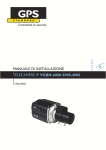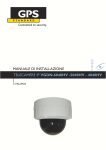Download PixelPro Series User's Manual ZN-C2M/ZN-C1M/ZN-C1 Ver1
Transcript
PixelPro Series User’s Manual ZN-C2M/ZN-C1M/ZN-C1 Ver1.30 PixelPro Series User’s Manual ZN-C2M/ZN-C1M/ZN-C1 Ver1.30 Contents 1. Product Features ............................................................................ 4 2. Accessing the Camera .................................................................... 7 2.1 2.2 2.3 2.4 2.5 2.6 2.7 Access from a Web Browser ...................................................... 7 Accessing the Camera from the Internet ...................................... 7 Adjusting the Image and Focus .................................................. 8 Back Focus Adjustment............................................................. 8 Live View ................................................................................. 9 Video stream types ................................................................... 9 How to Stream H.264...............................................................10 3. Setup .......................................................................................... 11 4. Installation ................................................................................... 11 4.1 Installation Mode .....................................................................11 5. Camera and Image ....................................................................... 12 5.1 Video Codec ...........................................................................12 5.2 Camera..................................................................................15 5.2.1 Exposure Control ..................................................................15 5.2.2 Day & Night Control ..............................................................16 5.2.3 White Balance Control ...........................................................16 5.2.4 Image Property Control..........................................................16 6. Audio .......................................................................................... 17 7. Live ............................................................................................ 18 8. SD Card ...................................................................................... 19 8.1 8.2 8.3 Configuration ..........................................................................19 Event .....................................................................................20 Periodical ...............................................................................21 9. FTP ............................................................................................ 22 9.1 9.2 9.3 Configuration ..........................................................................22 Event .....................................................................................22 Periodical ...............................................................................23 PixelPro Series User’s Manual ZN-C2M/ZN-C1M/ZN-C1 Ver1.30 10. Event ........................................................................................ 24 10.1 10.2 10.3 Alarm Port ............................................................................24 Motion .................................................................................25 Mapping ...............................................................................26 11. Network ..................................................................................... 27 11.1 11.2 11.3 11.4 11.5 11.6 IP Setup ...............................................................................27 Service Port ..........................................................................29 RTP .....................................................................................30 E-mail .................................................................................30 DDNS ...................................................................................31 UPnP ...................................................................................32 12. System ...................................................................................... 34 12.1 12.2 12.3 12.4 User.....................................................................................34 Date & Time ..........................................................................34 Maintenance .........................................................................35 Information ...........................................................................37 PixelPro Series User’s Manual ZN-C2M/ZN-C1M/ZN-C1 1. Ver1.30 Product Features The GANZ PixelPro Series HD / Megapixel IP camera (ZN-Cx) is a high performance H.264 network camera, designed for demanding security installations. It delivers crisp, clear images, disclosing every detail, thanks to its top quality progressive-scan CMOS sensor and advanced image processing. GANZ PixelPro features a mechanical IR cut filter, which enables color video in high and low light conditions, as well as IR sensitivity in ‘night’ mode. Supported by the industry’s largest base of video management software, the GANZ PixelPro provides the perfect solution for securing bank offices, airports and other facilities, and for traffic surveillance, over IP based networks. The optimal Power over Ethernet (IEEE 802.3af) supports power to the camera to be delivered via the network, eliminating the need for a power outlet and reducing installation costs. Reliable AC power could be guaranteed by using an Uninterruptible Power Supply (UPS). The GANZ PixelPro offers a comprehensive set of network security and management features. This includes support for port based network control (IEEE802.1X), which allows the camera to be connected to a network secured with this control and HTTPS encryption, which provides a secure channel between camera and application. It also enables authentication of the video source. GANZ video products are efficiently managed with the powerful GANZ DMS Client Software, which is provided on the Installation CD which comes with each GANZ PixelPro camera. PixelPro Series User’s Manual ZN-C2M/ZN-C1M/ZN-C1 Ver1.30 1. Alarm & Audio I/O (8-pin connection terminal) Audio in Audio in (line level), for line-in mono signal (only left channel is used from a stereo signal) Audio out The Audio output (line level), which could be connected to a line output of a microphone system or an active speaker with a built-in amplifier. Alarm in One digital photo-coupled input Alarm out One digital photo-coupled output (200mA) 2. Video Out (Analog BNC video output) 3. Micro SD Card Save snapshot images onto a Micro SD card. 4. Network connector The GANZ PixelPro connects to the network via a standard network cable, and automatically detects the speed of the local network segment (10BaseT/100BaseTX Ethernet). This socket could also be used to power the GANZ PixelPro via Power over Ethernet (PoE). The camera auto-senses the correct power level when using a PoE switch, router or injector. PixelPro Series User’s Manual ZN-C2M/ZN-C1M/ZN-C1 Ver1.30 5. Factory Default / Control Button Press this button to install the camera using the GANZ Dynamic Domain Name Service (DDNS), or to restore the camera configuration to its factory default settings. 6. Power Connector 12VDC or 24VAC power connector 7. Status LED Indicator LED Network Color Indication System Status Green On Connection to 10/100Mbps Network / LAN. Amber Flash Indication of network activity. Unlit - No network connection established. On Network connection is established. Flash Camera is booting up. Firmware Upload in progress. Factory Default in progress Green Status Red Flash 8. DC Auto Iris 4-pin DC Auto Iris connection from lens to camera. PixelPro Series User’s Manual ZN-C2M/ZN-C1M/ZN-C1 2. Ver1.30 Accessing the Camera Follow the instructions in the GANZ PixelPro Installation Guide to install the camera. The GANZ PixelPro can be accessed with most standard operating systems and browsers. The recommended browser is Internet Explorer for Windows. 2.1 Access from a Web Browser 1. Launch a web browser (Internet Explorer or compatible equivalent) 2. Enter the IP address (or name server address) of the camera into the Address Bar. 3. Login dialog will appear when the camera is accessed for the first time. 4. The default username is ADMIN and the default password is 1234. 5. The camera’s Live View page is now displayed in your browser. NOTE: The layout of the live view page in the camera may have been customized to meet specific requirements. Consequently, some of the examples and functions featured here may differ from those displayed on your own Live View page. 2.2 Accessing the Camera from the Internet Once installed, the camera will be accessible on the Local Area Network (LAN). Then, you must configure the router/firewall to allow incoming data traffic to access the camera from the Internet. For security reasons this is usually done on a specific port, using port forwarding. Please refer to the documentation for router/firewall for further instructions on port forwarding. PixelPro Series User’s Manual ZN-C2M/ZN-C1M/ZN-C1 2.3 Ver1.30 Adjusting the Image and Focus To adjust the position of the lens: 1. Open the Live View page in your web browser. - Select Setup tab, and open the Installation page. - Set “Installation Mode” to “ON” and select the “Video Format”. 2. Connect analog monitor to VIDEO OUT on rear panel of camera. - Unscrew the zoom puller on the lens by turning it anti-clockwise. - Adjust the zoom setting and re-tighten the zoom puller. - Unscrew the focus puller on the lens to adjust the focus, and re-tighten the focus puller. 3. Check the image in the Live View page in your web browser, and set “Installation Mode” OFF in Installation page in Setup tab. NOTE: DC Auto-Iris should always be disabled while focusing the camera. This will set the iris to the wide open position, which yields the smallest depth of field, and thus the best conditions for focusing the lens. When the focus has been set by using this method, it will maintain its focus in any kind of lighting conditions. 2.4 Back Focus Adjustment When the lens is changed to a non-standard lens or when the focus achieved using the instructions above is not satisfactory, perform back focus adjustment as follows: 1. Loosen the flange back locking screw that holds the C/CS-mount ring. CS-mount is standard on GANZ PixelPro. In case your lens is C-mount type, please use the 5mm adapter ring, which is provided in the product packaging. 2. Direct the camera towards an object at least 10 feet (3 m) away, set the zoom puller to wide-angle and adjust the back focus by rotating C/CS-mount ring. 3. Set the zoom puller to the most telephoto setting, and ensure that the image is still in focus. 4. Direct the camera towards a close object, about 1 foot (30cm) away. wide-angle, and ensure that the image is still in focus. Set the zoom puller to 5. Set the zoom puller to telephoto again and ensure that the image is still in focus. 6. Tighten the screw that holds the C/CS-ring again. 7. After making the back focus adjustment as explained above, you may now adjust the zoom and focus position to the desired setting. PixelPro Series User’s Manual ZN-C2M/ZN-C1M/ZN-C1 2.5 Ver1.30 Live View Client PC Speaker (enable / disable) Client PC Microphone (enable / disable) Digital Zoom Snapshot Full Screen Video Stream Change (1st Stream <> 2nd Stream) Play: Start Video Stream Stop: Stop Streaming NOTE: It is possible that not all the buttons described below will be visible unless the Live View page has been customized to display them. 2.6 Video stream types Motion JPEG This format uses standard JPEG images in the video stream. These images are then displayed and updated at a rate sufficient to create a stream that shows constantly updated motion. The Motion JPEG stream uses considerable amounts of bandwidth, but also provides excellent image quality and access to every individual image contained in the stream. H.264 Protocols & Communication Methods - RTP (Real-time Transport Protocol) is a protocol that allows programs to manage the real-time transmission of multimedia data, via unicast or multicast. - RTSP (Real-Time Streaming Protocol) serves as a control protocol, to negotiate the type of transport protocol used for the stream. RTSP is used by a viewing client to start a unicast session - UDP (User Datagram Protocol) is a communications protocol that offers limited service for exchanging data in a network which uses the Internet Protocol (IP). UDP is an alternative to the Transmission Control Protocol (TCP). The advantage of UDP is that it is not required to deliver all data and may drop network packets when there is network congestion. This is suitable for live video, as there is no point in re-transmitting old information that will not be displayed anyway. PixelPro Series User’s Manual ZN-C2M/ZN-C1M/ZN-C1 Ver1.30 H.264 Protocols & Communication Methods (continued) Unicasting is communication between a single sender and a single receiver over a network. This means that the video stream is transmitted independently to each user, and each user receives their own video stream. A benefit of unicasting is in case one stream fails, it only affects one user. Multicasting is bandwidth-conserving technology that reduces bandwidth usage by simultaneously delivering a single stream of information to multiple network recipients. This technology is used primarily on delimited networks (intranets), as each user needs an uninterrupted data flow and should not rely on network routers. 2.7 How to Stream H.264 Deciding on the combination of protocols and methods to use depends on your viewing requirements and on the properties of your network. Setting the preferred method(s) is done in the control applet for AMC, which is found in the Windows Control Panel. When this has been set, AMC will test all the selected methods in the specified order, until the first functioning one is found. RTP+RTSP This method (actually RTP over UDP and RTSP over TCP) should be your first consideration for live video, especially when it is important to always have an up-todate video stream, even if some images are lost due to network problems. This could be configured as multicast or unicast. Multicasting provides the most efficient usage of bandwidth, especially when there are large numbers of clients viewing simultaneously. Note however, that a multicast broadcast could not pass a network router unless the router is configured to allow this. For example, it is not possible to multicast over the Internet. Unicasting should be used for video-on-demand broadcasting, so that there is no video traffic on the network until a client connects and requests the stream. However, as more and more unicast clients get connected, the traffic on the network will increase and may cause congestion. Although there is a maximum of 10 unicast viewers, note that all multicast users combined count as 1 unicast viewer. RTP/RTSP This unicast method is RTP tunneled over RTSP. This could be used to exploit the fact that it is relatively simple to configure firewalls to allow RTSP traffic. RTP/RTSP/HTTP or RTP/RTSP/HTTPS These two methods could also be used to traverse firewalls. Firewalls are commonly configured to allow the HTTP protocol, allowing RTP to be tunneled. PixelPro Series User’s Manual ZN-C2M/ZN-C1M/ZN-C1 3. Ver1.30 Setup The GANZ PixelPro is configured from the Setup tab, which is available on the upper-left hand side in the web interface. This configuration could be performed by: - Administrators, who have unrestricted access to all settings under the Setup tab. - Users, who have access to the Video & Image, Live View, and Event Configuration sections. Accessing the Setup link from a browser: 1. Start your web browser and enter the IP address or name server address of the camera into the address bar. 2. The Live View page is now displayed. Click on the Setup tab. 4. Installation The following descriptions show examples of some of the features available with GANZ PixelPro. 4.1 Installation Mode Installation Mode allows use of the analog BNC output from the camera to connect the camera to a service monitor, in order to adjust the positioning of the camera and focus the lens. ON : Analog Output is enabled; both IP video streams are set to VGA (640 x 480) resolution. NOTE: You must turn Installation Mode OFF to utilize the Megapixel features of the camera. PixelPro Series User’s Manual ZN-C2M/ZN-C1M/ZN-C1 5. Ver1.30 Camera and Image The following descriptions show examples of some of the features available with GANZ PixelPro. 5.1 Video Codec This section allows you to choose the compression codec for each of the video streams. Motion JPEG This format uses standard JPEG still images in the video stream. These images then are displayed and updated at a rate sufficient to create a stream that shows constantly updated motion. The Motion JPEG stream uses considerable amounts of bandwidth, but also provides excellent image quality and access to every individual image contained in the stream. Multiple clients accessing Motion JPEG streams could use different image settings. H.264 This is a video compression standard that makes good use of bandwidth and could provide high-quality video streams at less than 1 Mbit/s. The H.264 standard provides the scope for a large range of different coding tools for use by various applications in different situations, and the GANZ PixelPro provides certain subsets of these tools. Using H.264, it is also possible to control the bit rate, which in turn allows the amount of bandwidth usage to be controlled. CBR (Constant Bit Rate) is used to achieve a specific bit rate by varying the quality of the H.264 stream. While using VBR (Variable Bit Rate), the quality of the video stream is kept as constant as possible, at the cost of a varying bit rate. PixelPro Series User’s Manual ZN-C2M/ZN-C1M/ZN-C1 Ver1.30 Size Video output resolution. See next page for camera resolution tables. Frame Rate 2.5 ~ 30fps in normal mode (1 ~ 30fps in slow shutter mode) NOTE: If the slow shutter mode is turned on and the low light condition is met, the image rate automatically goes down. In this case, the image is half of the normal mode. GOP Size 1 ~ 60 frames Bitrate Control (CBR or VBR) When using H.264 compression, if there is only limited bandwidth available, a constant bit rate (CBR) is recommended, although this may compromise image quality. Use a variable bit rate (VBR) for the best possibly image quality. Average Bitrate (512Kbps ~ 8Mbps) Recommended bit rate for VGA (640x480): 800Kbps ~ 1Mbps Recommended bit rate for 720p (1280x720): 3Mbps ~ 4Mbps Recommended bit rate for 1080p (1920x1080): 6Mbps ~ 8Mbps Quality 1 ~ 100 This parameter will be available in MJPEG mode. Anti-Flicker Mode 60Hz: NTSC 50Hz: PAL or “flicker-free” mode (to use the camera in locations lit by fluorescent lighting). Video Mirroring Select Video Mirroring mode NONE/ HORIZONTAL / VERTICAL / FLIP(H+V) Bandwidth Limit Limit the bandwidth that the GANZ PixelPro can use during a network connection. Max Bandwidth Specify the maximum bandwidth that the GANZ PixelPro can use during a network connection. PixelPro Series User’s Manual ZN-C2M/ZN-C1M/ZN-C1 Ver1.30 < Output resolution table for 1080p (Full HD) model > Second Stream First Stream 1080p (1920 x 1080) - - - 1.3MP (1280 x 1024) - - - 720p (1280 x 720) 720p Wide Mode (1280 x 720) XGA (1024 x 768) 720p (1280 x 720) ** VGA (640 x 480) QVGA (320 x 240) VGA (640 x 480) QVGA (320 x 240) - - 4CIF (704 x 480/576) - 4CIF (704 x 480/576) CIF (352 x 240/288) VGA (640 x 480) - VGA (640 x 480) QVGA (320 x 240) CIF (352 x 240/288) - CIF (352 x 240/288) - QVGA (320 x 240) - QVGA (320 x 240) 720p Wide Mode ** (1280 x 720) - ** Only available MJPEG mode. nd Frame rate will be limited 15fps on both 1 and 2 stream. < Output resolution table for 720p (HD) model > First Stream Second Stream 1.3MP (1280 x 1024) - - 720p (1280 x 720) - - 720p Wide Mode (1280 x 720) VGA (640 x 480) QVGA (320 x 240) XGA (1024 x 768) - - 4CIF (704 x 480) 4CIF (704 x 480) CIF (352 x 240) VGA (640 x 480) VGA (640 x 480) QVGA (320 x 240) CIF (352 x 240) CIF (352 x 240) - QVGA (320 x 240) QVGA (320 x 240) - < Output resolution table for VGA model > First Stream st Second Stream 4CIF (704 x 480) 4CIF (704 x 480) CIF (352 x 240) VGA (640 x 480) VGA (640 x 480) QVGA (320 x 240) CIF (352 x 240) CIF (352 x 240) - QVGA (320 x 240) QVGA (320 x 240) - PixelPro Series User’s Manual ZN-C2M/ZN-C1M/ZN-C1 5.2 Ver1.30 Camera This section allows you to adjust various camera settings. 5.2.1 Exposure Control Exposure Mode AUTO (indoor) : Use this setting for automatic exposure control at indoor. AUTO (outdoor) : Use this setting for automatic exposure control at outdoor. MANUAL : Use these settings to control camera exposure manually. To compensate for poor lighting conditions, you can adjust the Color level, Brightness, Sharpness, Contrast, Exposure control, and DC-Iris. NOTE: When AE is enabled, some of the submenus (AGC Gain, e-Shutter Speed) will be disabled. Slow Shutter Mode For low light conditions, turn on slow shutter mode. PixelPro Series User’s Manual ZN-C2M/ZN-C1M/ZN-C1 Ver1.30 Max AGC Gain For low light conditions, adjust to a higher value, such as 30dB. DC Auto-Iris Control Disable the DC Auto-Iris lens setting when focusing the lens. NOTE: Follow the instructions in Chapter 2.3, and enable the DC Auto-Iris function when finished. BLC Control (Back Light Compensation) The BLC adjusts the exposure of scenes with strong backlight in the center-bottom of the image. When the image background is too bright, or the subject too dark, backlight compensation makes the subject appear clearer. The settings for low light behavior determine how the camera behaves at low light levels. These settings affect video image quality and how much noise is in the images. 5.2.2 Day & Night Control Day & Night Mode Auto / On / Off Set this filter to OFF to allow the camera to 'see' infrared light, removing the IR cut filter, when using an IR illuminator. This will make the image clearer. If set to Auto, the camera will automatically switch between IR cut filter On and Off, according to the current lighting conditions. 5.2.3 White Balance Control WB Mode ON: ATW (Automatic White Balance) OFF: MWB (Manual White Balance) The White balance adjustment setting is used to make the colors in the image appear consistent, compensating for the different colors present in different light sources. The GANZ PixelPro camera can be set to automatically identify the light source and compensate for its color temperature. If necessary, the type of light source could be set manually. 5.2.4 Image Property Control Modify the video signal parameters, such as: Brightness, Sharpness, Contrast, Color, and Hue. Brightness (0 ~ 30; Default: 15) Sharpness (1 ~ 15; Default: 8) Contrast (0 ~ 30; Default: 15) Color (0 ~ 30; Default: 15) Hue (0 ~ 30; Default: 15) PixelPro Series User’s Manual ZN-C2M/ZN-C1M/ZN-C1 6. Ver1.30 Audio The GANZ PixelPro can transmit audio to other clients, and can also play audio received from other clients. This section describes the basic audio settings, such as setting the communication codec, and adjusting the sound levels for the microphone and speakers connected to the camera. Enable Audio ON / OFF: Check this to enable audio in the GANZ PixelPro. Codec G.711 u-law Audio Input Audio from a connected line-in source can be connected to the Audio in connector on the GANZ PixelPro camera. If there are problems with the sound input being too low or high, you can adjust the input gain for the microphone connected to the GANZ PixelPro. PixelPro Series User’s Manual ZN-C2M/ZN-C1M/ZN-C1 7. Ver1.30 Live GANZ PixelPro can support up to 10 simultaneous users via unicast. With multicasting, GANZ PixelPro can support an unlimited number of users. If supported on the network, consider using the multicast function, as the bandwidth consumption will be much lower. Viewer Setup Live View Protocol RTP Unicast (UDP) / RTP Multicast (UDP) / RTP over RTSP (TCP) Buffering Time (frame based) Determines (0 ~ 90) x 1/30 sec (0 ~ 3sec) Viewer OSD Setup Date: Determines whether the date is displayed. Resolution: Determines whether the camera resolution is displayed. Event State: Determines whether the event state is shown on display window. Event State: (as shown in Live View) AI : Alarm In AO : Alarm Out M : Motion PixelPro Series User’s Manual ZN-C2M/ZN-C1M/ZN-C1 8. 8.1 Ver1.30 SD Card Configuration SD Card Configuration This configuration page allows you to save still images to the Micro SD (SDHC) card. NOTE: This function cannot be used when Installation mode is turned ON. Set the first stream to 1280x720 or 1280x720(wide) in the Video > Codec section, and second stream to MJPEG or ‘None’. Overwriting The system will overwrite the oldest data on the SD card to continually record the newest data. SD Status Shows present SD card status. It also shows whether the SD card is present and the capacity left on it in kilobytes (KB). Mount / Unmount The Mount button notifies the system after the SD card is inserted. The Unmount button is to notify the system before the SD card is removed. This is a similar function to the ‘remove the hardware safely before taking out the USB’ in the Windows OS. NOTE: The user can download the images from the SD card using the FTP function. Turn FTP server on and connect to the camera. See Chapter 9.1 for details. PixelPro Series User’s Manual ZN-C2M/ZN-C1M/ZN-C1 8.2 Ver1.30 Event Event SD Writing You can configure the camera to store still images based on events such as Alarm In and Motion detection. NOTE: This function cannot be used when Installation mode is turned ON. Set the first stream to 1280x720 or 1280x720(wide) in the Video > Codec section, and second stream to MJPEG or ‘None’. SD Writing SD Writing will Enable / Disable event recording to the SD card. When Disabled, all remaining menus will be deactivated. Directory The name of the sub-directory where the still images will be stored when an Event occurs. File Prefix You may add a file name prefix to the stored image file name. Example: If the file prefix is ‘alm’, the still image would be saved as alm_date_time.jpg. SD Write Mapping Choose which types of events will be recorded to the SD card by checking the desired event. Effective Period lets you decide whether to save all the events that are happening at all hours of the day, or only the events that occur within during specific times of the day. The Schedule method is used to save events on the SD card during a specific time range. The start time and the end time can be set using the dropdown list. PixelPro Series User’s Manual ZN-C2M/ZN-C1M/ZN-C1 8.3 Ver1.30 Periodical Periodical SD Writing It is setting page to save the still images in the Micro SD card periodically. NOTE: This function cannot be used when Installation mode is turned ON. Set the first stream to 1280x720 or 1280x720(wide) in the Video > Codec section, and second stream to MJPEG or ‘None’. The Directory and File Prefix fields are same as on the SD Card > Event page. Interval allows for saving still images based on frequency (1 image every 10 sec, for example). Use the drop-down control to set from 10 seconds to 1 hour. Effective Period is also configured the same as on the SD card > Event page. Periodically, it saves the still image during a specific time range only. PixelPro Series User’s Manual ZN-C2M/ZN-C1M/ZN-C1 9. 9.1 Ver1.30 FTP Configuration Server Configuration Enable / Disable the FTP function to download saved content from the SD Card remotely. When it is Enabled, the FTP client can download the saved content without removing the SD Card. Client Configuration Allows transmission of still images to remote sites, using the FTP server. Set the information for FTP transmission by inserting the IP address, Username and Password of the remote FTP Server. NOTE: This function cannot be used when Installation mode is turned ON. Set the first stream to 1280x720 or 1280x720(wide) in the Video > Codec section, and second stream to MJPEG or ‘None’. 9.2 Event PixelPro Series User’s Manual ZN-C2M/ZN-C1M/ZN-C1 Ver1.30 Event FTP Sending Allows transmission of still images to the FTP server at remote sites when an event occurs. NOTE: This function cannot be used when Installation mode is turned ON. Set the first stream to 1280x720 or 1280x720(wide) in the Video > Codec section, and second stream to MJPEG or ‘None’. The menu structure is similar to the SD Card >Event menu, but instead of saving the still image to the SD card on an event, it transmits to the FTP server configured in the FTP > Config menu. 9.3 Periodical Periodical FTP Sending Allows transmission of still images periodically to the FTP server of remote sites. NOTE: This function cannot be used when Installation mode is turned ON. Set the first stream to 1280x720 or 1280x720(wide) in the Video > Codec section, and second stream to MJPEG or ‘None’. The menu configuration is similar to the SD Card >Periodical menu, but instead of saving the still images to the SD card on an event, it transmits to the server configured in the FTP > Config menu. PixelPro Series User’s Manual ZN-C2M/ZN-C1M/ZN-C1 10. Ver1.30 Event 10.1 Alarm Port Alarm Input Used for connecting external alarm contacts and triggering specific alarm-based events. The input is typically connected to a motion detector or any other external security device, so that recording can be triggered and/or still images could be recorded and/or uploaded whenever the sensor is activated. Maximum of 5VDC is allowed through this input. Alarm Output This could drive a maximum load of 50VDC or 35VAC at 110mA directly or heavier loads by connecting additional relay circuitry. If the output is used with an external relay, a diode must be connected in parallel with the load for protection against any voltage transients. Duration This parameter sets the minimum period before the alarm reset. Another alarm will not be triggered until this period has lapsed, even if the tampering conditions are otherwise met. This could help to prevent false alarms for known conditions that affect the image. Caution! Connecting AC to the inputs / outputs will damage the unit! PixelPro Series User’s Manual ZN-C2M/ZN-C1M/ZN-C1 Ver1.30 10.2 Motion Motion Detection Motion detection is used to generate an alarm whenever movement occurs within the video image. A total of 4 motion detection zones can be configured. Configuring Motion Detection 1. Click Motion Detection in the Event Config menu. 2. Click ‘Add Window’, and select an area for motion detection by checking the relevant box. 3. Enter a descriptive name for the detection zone you are creating. 4. Adjust the size (drag the bottom right-hand corner) and position (click on the text at the top and drag to the desired position) of the motion detection zone you are creating. 5. Adjust the Object size, History and Sensitivity profile sliders. Any detected motion will be indicated by red peaks in the Activity window. 6. Click Save. NOTE: Using the motion detection feature will consume more of the cameras resources, and this could decrease the camera’s overall performance, depending on your settings. PixelPro Series User’s Manual ZN-C2M/ZN-C1M/ZN-C1 Ver1.30 10.3 Mapping Event Mapping It is possible to define conditions that would cause the camera to respond with certain actions. A triggered event happens as a result of an event which is mapped within this menu. This could be caused by motion detection or an external alarm input. Alarm Out events could be triggered by either Motion or Alarm In. E-mail notification could be sent by either Motion or Alarm In. PixelPro Series User’s Manual ZN-C2M/ZN-C1M/ZN-C1 11. Ver1.30 Network 11.1 IP Setup IP Address Configuration The GANZ PixelPro supports both IP version 4 and IP version 6 (IPv6 will be supported as of v3.0). Both versions may be enabled simultaneously, and at least one version should be always enabled. When using IPv4, the IP address could be set automatically via DHCP, or a static IP address could be set manually. If IPv6 is enabled, your camera receives an IP address according to the configuration within the network router. There are also options for setting up notification of changes in the IP address, and for using a Dynamic Domain Name Service (DDNS). NOTE: IP address assignment via DHCP may lead to the situation where the IP address changes and you lose contact with the camera. If your DHCP server can update a DNS server, you can access the GANZ PixelPro by a static host name, regardless of having a dynamic IP address. Configure the options for notification of IP address change (under Services) to receive notification from the camera when the IP address changes. DNS Configuration DNS (Domain Name Server) provides the translation of host names to IP addresses on your network. Primary DNS server Enter the IP address of the Primary DNS server for your network. Secondary DNS server Enter the IP of the Secondary DNS, which is used if the Primary DNS server is unavailable. PixelPro Series User’s Manual ZN-C2M/ZN-C1M/ZN-C1 Ver1.30 How to Assign an IP Address Default setting is set to “DHCP” and “UPnP” function is set to ON. If your network has a DHCP server and the UPnP function is enabled on your PC, you can find the camera in “My Network”. Execute the PixelPro Discovery Tool (from the Installation CD). automatically. It will search cameras on the network 1) After the list of detected devices appears, select the camera you are trying to configure. 2) Enter all of the network information for your camera. 3) Click “Apply” button. When you double-click the camera within the list, the default web browser (Internet Explorer, or compatible equivalent) will open and automatically connect to the camera. PixelPro Series User’s Manual ZN-C2M/ZN-C1M/ZN-C1 11.2 Ver1.30 Service Port Service Port HTTP port The default HTTP port number (80) could be changed to any port within the valid port range (1-65535). This is useful for simple port mapping. RTSP port The RTSP protocol allows a connecting client to start an H.264 stream. Enter the RTSP port number to use. The default setting is 554. HTTPS port (HTTPS will be supported in v3.0) The default HTTPS port number (443) could be changed to any port within the valid range (1024-65535). HTTPS is used to provide encrypted web browsing. NOTE: After changing the default port numbers, the user can use the ‘PixelPro Discovery Tool’ to search and connect automatically if they can’t remember the specific port numbers that they used. PixelPro Series User’s Manual ZN-C2M/ZN-C1M/ZN-C1 11.3 Ver1.30 RTP RTP Port Range The IP address, port number, and Time-To-Live (TTL) value to use for the video stream(s) in multicast H.264 format. Only certain IP addresses and port numbers should be used for multicast. 11.4 E-mail You must turn Notification to ‘On’ and then enter the host names or addresses for your mail servers in the fields provided, to enable the sending of event and error email messages from the camera to predefined addresses via SMTP. PixelPro Series User’s Manual ZN-C2M/ZN-C1M/ZN-C1 11.5 Ver1.30 DDNS The GANZ Dynamic Domain Name Service (DDNS) can provide your GANZ product with its own name server address (URL), which can then be used to access it over the Internet. The product can be unregistered from the service at any time. To do this click Network > DDNS and turn the DDNS off. How to setup the DDNS: 1) DDNS set to ON. “mac address.dvrlink.net” is registered to the DDNS server. User can connect to the camera with: “http://mac address.dvrlink.net”. 2) DDNS set to ON and user inputs “user-defined name”. “mac address.dvrlink.net” and “user-defined name.dvrlink.net” are both registered together. User can connect to the camera using either: “http://mac address.dvrlink.net” or “http://user-defined name.dvrlink.net”. If “user-defined name” is already registered, an error message is shown, try a different name. PixelPro Series User’s Manual ZN-C2M/ZN-C1M/ZN-C1 11.6 Ver1.30 UPnP Universal Plug & Play (UPnP) allows you to find the IP camera automatically on your network. PixelPro Series User’s Manual ZN-C2M/ZN-C1M/ZN-C1 Ver1.30 In order to be able to detect the camera automatically, you must enable the UPnP function on both the camera and on your PC. Camera : Set UPnP to “ON” PC : Open “Control Panel” >”Network Connection” Select “Advanced” >”Optional Networking Components…” Select “Network Services” and click “Details”. Then select “UPnP user Interface” PixelPro Series User’s Manual ZN-C2M/ZN-C1M/ZN-C1 12. Ver1.30 System 12.1 User When you access the camera, the Configure Root Password dialog box appears. Enter the user name ADMIN and password 1234 to log in. To change the password or add a user, go to Setup > System > User. Fill in the User ID, Password and E-mail server. Select the Group. Then press the ‘ADD’ button and click ‘SAVE’. NOTE: 12.2 The default administrator username ADMIN is permanent and cannot be deleted or altered. Date & Time Date & Time Format Specify the formats for the date and time (12h or 24h) displayed in the Live View video streams. Network Time Server Synchronize the time from an NTP server every 60 minutes. Specify the IP address or host name of the NTP server you are using. PixelPro Series User’s Manual ZN-C2M/ZN-C1M/ZN-C1 Ver1.30 Local Time / PC Sync/SAVE Specify Local time manually or Synchronize to PC time automatically. Time Zone Setup You may select your time zone from the drop-down list. D.S.T (Daylight Saving Time) Toggle automatic DST clock adjustment on/off. 12.3 Maintenance System Name Choose a system name to identify the camera when using e-mail notifications. System Reboot Reboots the camera. Factory Default To reset the camera back to the original factory default settings. Save User Data System settings can be saved to a PC. Load User Data The system settings can be reloaded in case of accidental factory reset or can be transferred to another camera if multiple units need to be installed with the same settings. Firmware Update From time to time, CBC will release firmware updated for the PixelPro Series camera, which will contain feature additions and other improvements. Always read the upgrade instructions and release notes that accompany each new firmware release, before updating the firmware. NOTE: Preconfigured and customized settings should be saved before the firmware is upgraded. PixelPro Series User’s Manual ZN-C2M/ZN-C1M/ZN-C1 Ver1.30 Firmware Update Procedure 1. Save the firmware file to your computer. 2. Go to Setup > System > Maintenance within the camera web browser setup. 3. In the Firmware Update section, browse to the desired firmware file on your computer. Click OK. NOTE: Do not disconnect power to the unit during the upgrade. The unit will restart automatically after the upgrade has completed. (1~5 minutes) 4. If you suspect the firmware upgrade for the camera has failed, always wait at least 5-10 minutes before restarting the upgrade process. 5. CBC reserves the right to charge for any camera repair which can be attributed to faulty upgrading by the user. Always read the upgrade instructions and firmware release notes before updating the firmware. System Reboot There are two ways to reboot the camera. Using the web browser: 1. Go to SETUP > System > Maintenance. 2. Click System Reboot Button and wait 1 minute for camera to reboot. Using the Reset Button on rear panel of the camera: 1. Press the Reset button pressed until the Status Indicator color changes to RED. 2. Release the Reset button. 3. When the Status Indicator changes to Green (which may take up to 1 minute), the process is complete and the camera has been reset. Factory Default There are two ways to reset the camera back to factory default. Using the web browser: 1. Go to SETUP > System > Maintenance. 2. Click Factory Default Button and wait 1 minute for camera to reboot. Using the Reset Button on rear panel of the camera: 1. Press the Reset button pressed until the Status Indicator color changes to RED and starts blinking (which may take up to 15 seconds). 2. Release the Reset button. 3. When the Status Indicator changes to Green (which may take up to 1 minute), the process is complete and the camera has been reset. NOTE: The unit will now have the default IP address from a DHCP server. Use the ‘PixelPro Discovery Tool’ to discover and connect to the camera. PixelPro Series User’s Manual ZN-C2M/ZN-C1M/ZN-C1 12.4 Information System Information After updating firmware, you can confirm the new F/W version here. Ver1.30 PixelPro Series User’s Manual ZN-C2M/ZN-C1M/ZN-C1 Ver1.30 PixelPro Series User’s Manual ZN-C2M/ZN-C1M/ZN-C1 Ver1.30 PixelPro Series User’s Manual ZN-C2M/ZN-C1M/ZN-C1 Ver1.30

















































